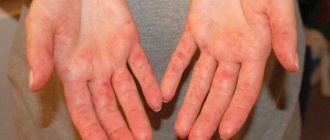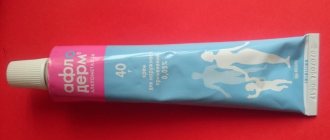When spots appear on the heels at any age, this indicates a sign of an unhealthy body, causing discomfort and unpleasant sensations. Heels may peel, itch, and hurt when walking. Similar manifestations often appear in people who have previously been exposed to long-term exposure to low temperatures on their heels. In addition, red heels appear in those who have increased skin sensitivity and wear uncomfortable shoes. Sometimes redness of the heels indicates serious pathologies - diabetes, mycosis. To eliminate the problem, you should not carry out independent treatment, but consult a doctor.
Types of rashes
Rash refers to a broad medical concept. A large number of reasons lead to its appearance. Rashes are pathological elements on the skin and mucous membranes, differing in color and texture.
Colorless and white rashes
When white spots on the sole of the foot do not cause any discomfort, being only a cosmetic defect, they speak of the presence of vitiligo.
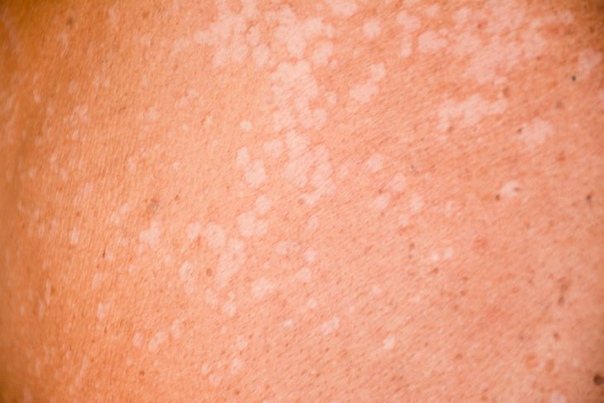
White spots (vitiligo)
It develops when the dermis loses its natural pigmentation due to changes in melanin. Then individual parts of the body lose their normal color, which leads to the appearance of white spots and variegation.
The factors for the development of vitiligo in the foot area have not been fully identified. Certain pathological processes, drug use, hereditary factors, and stress can provoke the appearance of white spots on the soles of the feet.
Red rashes
Spots in the area of the feet can rise above the plane of the sole or be completely flat.
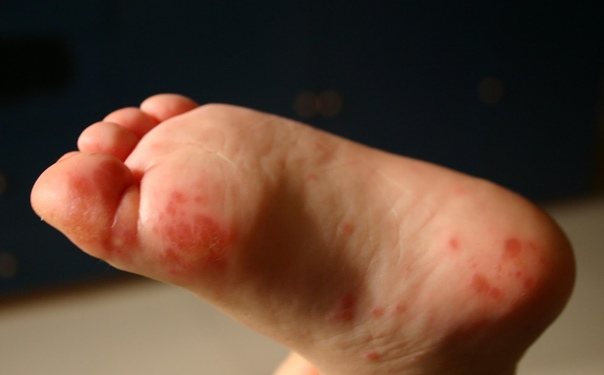
Red spots
Their colors range from pale pink to rich wine red. If the heel is red, a person may experience itching and peeling.
Often, any change in skin pigmentation is the result of an imbalance, a disease of the body - allergic reactions, an unbalanced diet, vascular changes, skin diseases.
Causes of rashes on feet and heels
The factors that cause red spots on the feet are the following:
- Deformation of the feet - develops due to increased impact on biologically active points on the heel, occurs in both children and adults.
- Development of allergies - if the skin comes into contact with an allergen, it will turn red.
- The spots on the feet may itch, peel, and the heels will become dry. Sometimes the heels are covered with a small rash that looks like blisters filled with fluid.
- Vitamin deficiency - a lack of vitamins may be the reason why the heel turns red.
- Insect bites - as a result of a bite, red spots appear on the heel, accompanied by a burning sensation and itching.
- The causes of a rash on the feet of a red color may lie in the presence of a burn, frostbite, or depilation.
- A common factor in the development of a red rash on the heel is tight, uncomfortable shoes that were made from low-quality materials.
The factors mentioned earlier are not dangerous. To eliminate red spots on the heels, it is enough to adjust your diet and change your shoes.
Rash on a child's feet or heels
The most common occurrences of rashes on the skin of children's feet are associated with allergic manifestations and inflammatory processes.

Rashes in a child
Allergic reactions include the following pathologies:
- Dyshidrosis. Red rashes are localized on the baby's arms, palms, feet, and heels. Hives may spread to the inside of the knees. The rash has the following character - these are bubbles of a transparent color, dense structure, located under the skin. The diameter of the rash reaches up to 1 mm. Such a rash on the heels of a child may cause irregular itching.
- Red spots on the heels may also indicate contact dermatitis. Often, the pathology begins with the appearance of peeling of the heels in adult children, and redness of the scab in young patients. Initially, the rash appears as small blisters, later becoming an area of severe peeling. The child feels severe itching, there is no suppuration or bruising.
Red spots on a child’s heel are formed due to viruses and infections. The atypical appearance of red dots on the heels may be due to an enterovirus infection. The symptoms are very similar to reovirus infection; abdominal pain, vomiting, diarrhea, and fever may also develop.
Both small reddish pimples and larger red pimples appear. The spots on the child's heel do not itch.
Self-medication when red dots are detected on the heel of children is prohibited; you should go to a doctor who, in a hospital setting, will identify the causes of the development of the rashes and prescribe appropriate therapy.
When is it necessary to see a doctor urgently?
Self-medication can be very dangerous in some cases. This is due to the rapid spread of rashes to neighboring areas, severe pain and itching.
You should seek medical help immediately if:
- increased body temperature, development of weakness;
- bleeding rashes, severe itching and tingling;
- swelling and redness of the insect bite area;
- detection of blackish, purple spots and the development of severe headaches.
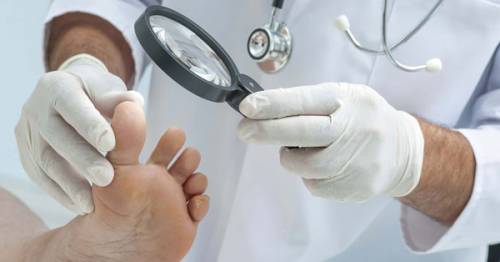
If additional symptoms appear or the nature of the rash changes, you should immediately consult a doctor
All these signs are a signal to call an ambulance. They may indicate the development of severe pathologies that require immediate treatment. If you lose time, the disease can progress.
Red spots on the feet are a symptom of certain diseases
Red heels can indicate the presence of a number of problems with a person’s health. Diseases in this case do not always affect the limbs; some diseases of the internal organs are often reflected on the skin.
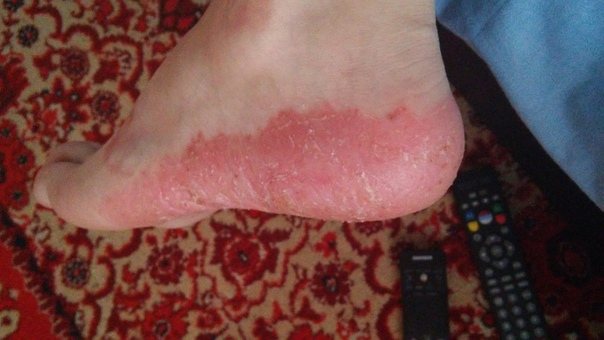
Red spots on the feet may be a symptom of an allergic reaction. The reason may be the use of new cosmetics, medicines, or food products. Allergies also occur to fabric dyes and their composition. It is imperative to find the red heel factor by undergoing certain allergen tests in the hospital.
The danger of red rashes may lie in suddenly formed spots on the soles. Symptoms may indicate the presence of vasculitis, where blood vessels become inflamed.
If you find such a rash, you should immediately go to the doctor.
Circulatory disorders
With constant manifestations of bruises on the limbs, red spots in the heels, this may indicate a pathology of the circulatory system. Due to blood clotting disorders, lack of vitamins, and use of medications, blood vessels become fragile.
Blue spots on the limbs appear as a result of:
- Liver problems
- Poor nutrition
- Varicose veins
This leads to weakening of the walls of blood vessels; the blood that protrudes from them is visible under the skin.
Viral diseases
Red spots in the heel area can appear due to chickenpox and measles. With these pathologies, holes with a small diameter appear. The rash can spread throughout the body.
A person faces a number of signs:
- Temperature rise
- Decreased ability to work
- Shiver
For diseases, antibacterial agents and antipruritic drugs are prescribed. It is important that the rash does not fester. Over time, the heels become crusty.
Allergic reactions
The most common factor in the development of foot allergies is incorrectly selected cosmetics or an individual reaction to procedures. As a result, red dots on the heels spread throughout the sole. Itching occurs, which causes discomfort.
Fungal diseases
The appearance of red scaly spots on the heels is observed due to a viral infection. The pathology manifests itself as itching, burning, and unpleasant odor. Similar symptoms are characteristic of mycosis.
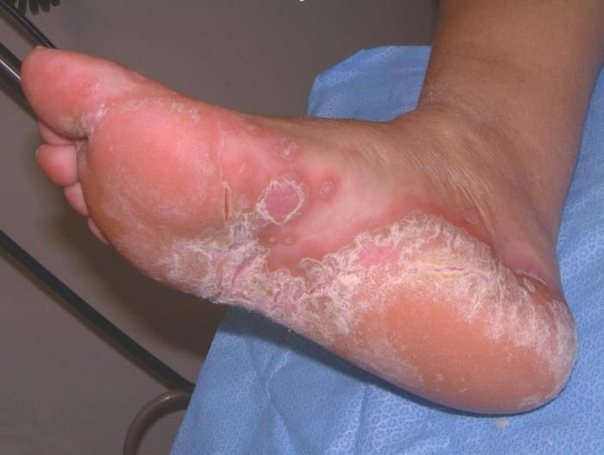
The disease manifests itself in small spots, with the possible formation of blisters. If you have a fungal infection of your heels, you need to visit a dermatologist and prescribe antifungal medications.
Hemangioma
Education refers to a benign neoplasm. In pathology, the vessels are intertwined with each other, forming a huge red zone. Hemangioma does not cause discomfort. It is recommended to remove the red tumor surgically.
Skin diseases
Psoriasis is a chronic autoimmune disease that affects the skin. An ordinary scratch or injury can lead to pathology. A characteristic symptom is red rashes on the heels in the form of plaques, flaky and accompanied by itching. The pathology is not contagious, but it is not curable.

Scabies is an infectious pathology that is quickly transmitted by the pathogen, which is the scabies mite. The main sign of the disease is red dots on the leg. The red spot on the heel causes severe itching, intensifying at night.
Diabetes
The pathology has a congenital and acquired course. Diagnosis and treatment of pathology is carried out by an endocrinologist. The formations have a symmetrical appearance and spots form on the feet, including the heels. The feet take on a dark cherry color.
If diabetes treatment is not started immediately, it will increase, which can trigger the development of gangrene.
Irritations due to mechanical and chemical influences
Redness of the heel and pain in this area appear as a result of incorrectly selected shoes, wearing socks, or synthetic tights. The spots on the heels may be dry and itchy. Basically, this manifestation disappears on its own after 2-3 days.
Heels also become red due to the influence of sunlight, heat, cold, and water. A person’s heel itches, the sole becomes hot, and he may feel feverish. When scratching the heel, the lesion will become even larger, changing the skin color from bright to dark.
Diagnostics
If red spots appear on your legs and itch, you need to consult a dermatologist. You will need to undergo certain diagnostics. Before doing this, you should not attack the stain with any means. This may distort the clinical picture. Diagnosis will be difficult. At the appointment, the doctor conducts an examination. The dermatologist also asks the patient about the symptoms that accompany the pathology. After this, a series of laboratory tests are carried out. Their list is quite large. The doctor writes a referral for:
Sometimes a biopsy is done to diagnose the cause of the disease. An area of skin taken from the patient is examined using a special technique. Allergies are detected using certain tests and samples. The type of allergen is also determined. For cholinergic urticaria, a provocative test is performed using an acetylcholine analogue drug.

If necessary, other instrumental diagnostics may be required. For example, a doctor may prescribe angiography of the vessels of the legs and their ultrasound examination. Sometimes it is necessary to diagnose the functioning of the liver and thyroid gland. Sometimes after the first series of tests, the dermatologist may order several additional examinations.
Spots on the legs itch and peel due to acute or chronic diseases. The symptoms of many of them are similar. In the acute period, diagnosis is easier. The manifestations of a certain disease are clearly expressed. Chronic diseases require in-depth diagnosis. If you independently determine the causes of the spots, you can worsen the condition. At the same time, some symptoms are hidden. Improper treatment can lead to serious complications and significantly prolong the recovery period.
First aid at home
Regardless of the development factors, redness on the heels must be treated. It is better to carry out therapy under the supervision of a specialist who knows the peculiarities of the occurrence of a particular pathology.
At home, you can try to eliminate red spots on your heels using traditional methods. If the cause is a fungal disease, make a bath of 0.5 liters of water, sea salt and a tablespoon of soda. Dilute the ingredients in warm water and steam your heels in the bath, leaving for 20 minutes. Carry out the manipulation for a week.

If psoriasis is present, a compress is applied to relieve the inflammatory process and minimize the space of the formations. Finely chop a medium onion and 5 cloves of garlic to obtain juice. The mixture is applied for 2 minutes.
For allergies, antihistamines are used.
Before using drugs, you should consult a specialist; independent treatment is prohibited.
Other pathologies
If spots on the leg appear and itch, treatment is prescribed in accordance with the causative agent of this process. Special fungicidal ointments and drops are used against fungus. If mycosis spreads to the nails, they need to be thoroughly cleaned. There is also a large selection of drops on sale that are applied to the nail in the morning and evening. Shoe treatment is also carried out using the selected preparation.
If the cause of the spots is liver pathologies, diabetes mellitus, treatment of the underlying disease is prescribed. In parallel with this, the doctor prescribes antiallergic drugs. In many cases, vitamin complexes are prescribed (depending on the type of underlying disease). This allows you to increase immunity and restore the body's protective functions. Sometimes physiotherapy treatment may be prescribed.

